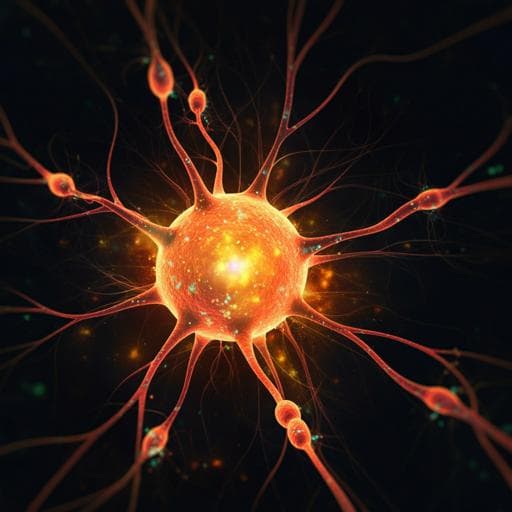
Medicine and Health
The single-cell transcriptomic atlas iPain identifies senescence of nociceptors as a therapeutical target for chronic pain treatment
P. Techameena, X. Feng, et al.
Chronic pain affects nearly 20% of adults worldwide and remains inadequately treated. This groundbreaking research by Prach Techameena, Xiaona Feng, Kaiwen Zhang, and Saida Hadjab unveils the role of nociceptor senescence in chronic pain progression. With promising senolytic treatments shown to alleviate pain in mice, the study highlights a potential breakthrough in pain management.
~3 min • Beginner • English
Introduction
Chronic pain affects approximately 20% of adults worldwide and remains difficult to treat effectively due to limited efficacy and side effects of current analgesics, many of which modulate signaling without addressing underlying causes. Pain is initiated by peripheral nociceptors located in dorsal root (DRG) and trigeminal ganglia (TG), which comprise distinct subtypes (PEP, NP, C-LTMR, SST). Advances in single-cell RNA sequencing have enabled detailed atlases of cellular heterogeneity and disease mechanisms. To uncover molecular programs driving pain chronification and shared mechanisms across models, the authors constructed integrated somatosensory single-cell/nuclei atlases for DRG (iPainDRG) and TG (iPainTG), integrating multiple public datasets with new multi-omic data. The study aims to chart temporal cell-state changes in nociceptors during pain progression and identify therapeutic targets.
Literature Review
Prior work established nociceptor diversity and injury-induced transcriptional reprogramming, including regeneration-associated genes (RAGs) such as Atf3 and Jun. Atlases have been generated across neurological disease contexts, and multi-omic integration frameworks (scVI/scANVI, MultiVI, SCGLUE) enable harmonization across datasets and modalities. Sox11 has been implicated in neuronal development and regeneration, with emerging evidence linking SOX11 to neuropathic pain initiation and maintenance. Cellular senescence, originally described in proliferative cells, is now recognized in post-mitotic cells and associated with aging and stress responses; the SenMayo gene set provides a standardized approach to identify SASP/senescence signatures. Previous studies linked senescence to chronic pain within the spinal cord months after injury and with some sex specificity; however, sustained relief was not achieved by targeting spinal senescence alone, suggesting upstream mechanisms. The present study investigates whether senescence of peripheral nociceptors is an early and shared driver of chronic pain.
Methodology
Data resources and atlas construction: The iPainDRG and iPainTG atlases integrate public sc/snRNA-seq and snATAC-seq datasets (e.g., GSE154659, GSE155622, GSE158892, GSE216039, GSE139088, GSE168032, GSE197289, GSE213105, GSE186421, GSE101984) with in-house Smart-seq3xpress and 10x multi-omic data (GSE253345). For DRG, scVI was trained on 3000 HVGs (50-d latent space; negative binomial) followed by scANVI for label transfer (Renthal et al. nomenclature) and visualization (UMAP; cosine metric; 100 neighbors; min_dist=0.5). MultiVI was trained to impute missing RNA and ATAC features using in-house multi-omic data as anchor; gene expression estimates via get_normalized_expression and ATAC accessibility via get_accessibility_estimates (threshold 0.1; normalization enabled; scaled x10,000). For TG, SCGLUE fused RNA and ATAC latent spaces (RNA from updated DRG-trained scANVI; ATAC via LSI) with a guidance graph.
Nociceptor analysis and temporal states: Nociceptive-lineage neurons were subset and reclustered (Leiden, res=0.1). UMAP density maps across timepoints (0–28 days post-injury) revealed trajectories from naïve to injury and return. Clusters were aggregated into macrostates: woPain (alignment with naïve/sham reference) and wPain (non-reference). Microstates combined macrostate and time: Reference (0d), Moving (≤1.5d in woPain), Pain (wPain excluding 28d), Recovery (>1.5–28d in woPain), and Lasting Pain (wPain at 28d). RNA velocity-based potency (CytoTrace) and CellRank GPCCA on transition matrices validated state dynamics and identified terminal states and driver genes per subtype. Regulon activity was inferred with pySCENIC; TF activities also estimated using univariate linear models with decoupleR; chromatin dynamics tracked via imputed ATAC peaks at promoter regions (e.g., Atf3, Sox11, Flrt3).
Cell–cell communication and pathway analysis: LIANA+ inferred ligand–receptor interactions across cell types and conditions; tensor decomposition (cell2cell) extracted communication Factors. PROGENY pathway enrichment was applied to ligand–receptor sets per Factor to identify pathways altered during pain progression.
Senescence quantification and validation: Senescence/SASP was quantified by SenMayo gene set scoring (Scanpy score_genes) on imputed, scaled RNA; top 10% z-score cells labeled SASP. Enrichment of GenAge and CellAge signatures (decoupleR GSEA) assessed cellular aging features. Statistical tests used Mann–Whitney U or t-tests as appropriate. Time-course SASP proportions were tracked in silico. In vivo, SA-β-gal staining (pH 6) on DRG sections from CCI-injured mice (days 0, 1, 7, 14, 28) quantified senescent areas; immunostaining for NeuN, peripherin, and p21 assessed neuronal identity and senescence markers.
Human and TG analyses: Human DRG bulk RNA-seq (Ray et al.) was renormalized from TPM to counts (scaled to median library size), log1p-transformed and scaled; SenMayo z-scores computed and compared between pain and no-pain donors. Bulk2Single (omicverse) deconvolution used Jung et al. hDRG snRNA-seq as reference to reconstruct single-cell-like profiles; clusters with <900 cells removed; nociceptors selected for SenMayo comparison. Diabetic neuropathy dataset (Hall et al.) TPM-normalized, pseudo-log transformed; sex regressed out; age outliers (<30, >60) removed; SenMayo z-score compared between diabetic pain and healthy. For TG, due to limited iPainTG timepoints, a rat trigeminal neuralgia model (TREZ compression) bulk RNA-seq dataset was used to compute SenMayo z-scores.
In vivo senolytic intervention: Adult C57BL/6 mice (both sexes; 17–27 weeks) underwent chronic constriction injury (CCI) of the sciatic nerve. Starting day 7 post-CCI, oral gavage of senolytics or vehicle was administered: Navitoclax (ABT-263) or Venetoclax once daily for 10 consecutive days; PROTAC Bcl-xL degrader once weekly for 2 weeks. Behavioral assays: mechanical allodynia (von Frey, up–down method), pinprick (0–4 score), and thermal sensitivity (Hargreaves). Safety and off-target assessments: body weight, full blood counts (erythrocytes, thrombocytes), anxiety (open field, elevated plus maze), and motor coordination (beam walk, rotarod). DRG were collected for SA-β-gal and peripherin co-staining to quantify senescent nociceptor proportions. Statistics used SciPy (paired/unpaired t-tests; Mann–Whitney U); Bonferroni correction when appropriate.
Key Findings
- Temporal nociceptor dynamics: Nociceptors traverse defined microstates (Reference, Moving, Pain, Recovery, Lasting Pain). Naïve cells localize to UMAP periphery; post-injury cells shift centrally; by day 28 many return peripherally, with a subset remaining in Lasting Pain.
- Transcriptional drivers: RAGs (e.g., Atf3, Jun) are upregulated early and decline later; Sox11 is a top driver across all nociceptor subtypes, with regulon activity increasing along pseudotime and remaining elevated in Lasting Pain, suggesting a role beyond regeneration in pain maintenance.
- Cell–cell communication: Tensor decomposition identified six Factors; Factor 3 showed the largest change between Reference and non-Reference states across pain models. PROGENY enrichment implicated the p53 pathway as most enriched, with p53, p21, and p16 expression elevated post-injury, indicating senescence involvement.
- Senescence signatures in mice: SenMayo z-scores increased across all neuropathic pain models relative to controls (except Paclitaxel), across dynamic states and nociceptor subtypes, in both sexes. Recovery state had significantly lower SenMayo than Pain and Lasting Pain. SASP-positive cell proportion increased with time post-injury. In vivo SA-β-gal staining increased after CCI, and nuclear p21 expression rose from day 7, confirming senescent phenotypes in a subset of small-diameter, NeuN-positive nociceptors.
- TG and human data: TREZ compression (rat TG) bulk RNA-seq showed elevated SenMayo scores vs. sham, suggesting senescence in trigeminal pain. Human DRG bulk RNA-seq from chronic pain patients showed higher SenMayo z-scores than controls (age-matched), including in deconvolved nociceptors (7418 control vs 6198 pain nociceptors; Mann–Whitney U, P=3.545×10^-11). Diabetic painful neuropathy DRG also showed higher SenMayo (one-sided t-test, P=0.00952), with no age differences between groups.
- Senolytic therapy efficacy in mice: Oral senolytics (ABT-263, Venetoclax, PROTAC Bcl-xL degrader) starting day 7 post-CCI significantly reduced or normalized mechanical hypersensitivity by 4 weeks post-injury compared with baseline/vehicle. Thermal sensitivity was not significantly altered at the tested doses/timeframes. DRG analysis showed selective removal of ≥50% of SA-β-gal+ cells among peripherin+ small-diameter neurons on average, representing a small fraction of total peripherin+ neurons. Safety: stable body weight; similar erythrocyte and thrombocyte counts between treated and control groups; no significant differences in anxiety (OFT/EPM) or motor function (beam walk, rotarod) vs. controls. Effects were sex-independent.
Discussion
The study demonstrates that peripheral nociceptors undergo a dynamic and conserved transcriptomic trajectory after nerve injury, culminating in a senescence phenotype within a subset of neurons that correlates with pain persistence. Elevated Sox11 activity across subtypes and its sustained regulon activity in Lasting Pain aligns with a role in maladaptive maintenance of chronic pain distinct from early regenerative programs (Atf3, Jun). Cell–cell communication analyses implicate p53 pathway activation, and combined expression of p53/p21/p16 further supports senescence during pain chronification. Senescence signatures were evident across diverse mouse pain models, in trigeminal injury (TREZ), and in human DRG from chronic pain and diabetic neuropathy cohorts, independent of age and sex, underscoring translational relevance. Pharmacological clearance of senescent nociceptors with senolytics reversed mechanical hypersensitivity without broad sensory, behavioral, or hematological side effects, suggesting that a small population of dysfunctional senescent neurons can sustain chronic pain and that their selective removal can restore function. These findings reframe chronic pain maintenance as, in part, a senescence-driven process in nociceptors and position senolytics as a promising therapeutic strategy where traditional analgesics fail to modify disease mechanisms.
Conclusion
This work introduces the iPain single-cell atlases (DRG and TG) integrating multi-omic data across pain models and timepoints to chart nociceptor state transitions during pain chronification. The analyses identify cellular senescence in a subset of nociceptors as a shared mechanism across models and species, with p53 pathway involvement and sustained Sox11 activity. Human DRG data corroborate increased senescence signatures in chronic pain and diabetic neuropathy. In vivo, senolytic agents targeting Bcl-2 family anti-apoptotic pathways reduce senescent nociceptor burden and reverse mechanical hypersensitivity in mice, with minimal adverse effects. These findings suggest repurposing senolytics for chronic pain and trigeminal headache disorders. Future research should: expand TG single-cell temporal coverage; validate long-term efficacy and safety of senolytics across pain etiologies and ages (including elderly); optimize dosing, timing, and compound specificity (e.g., Bcl-xL-sparing approaches); dissect subtype-specific contributions and upstream triggers of nociceptor senescence; and evaluate combination therapies with regenerative or anti-inflammatory strategies.
Limitations
- TG atlas had limited temporal coverage; senescence in trigeminal pain was inferred from an external rat TREZ bulk dataset rather than TG single-cell time courses.
- One neuropathic model (Paclitaxel) did not show significant SenMayo enrichment, indicating model-specific variability.
- Deconvolution of human bulk DRG introduced noise and broad cell-type resolution; neuronal subtype distinctions (NFs vs nociceptors) were imperfect, and class proportions differed from reference due to neuron-enriched sampling.
- The Lasting Pain state comprised relatively few cells (n=654), potentially limiting statistical power for late-stage analyses.
- In vivo therapeutic testing was performed in a single injury model (CCI), specific schedules, and limited time window; thermal hypersensitivity was not improved under tested conditions.
- Animal cohorts were young to middle-aged; effects in older animals and long-term outcomes beyond 28 days were not assessed.
- Senolytic compounds target Bcl-2 family pathways; while blood counts and behavior were unaffected here, broader safety, thrombocytopenia risk, and off-target effects warrant further evaluation and optimization (e.g., PROTAC Bcl-xL strategies).
Related Publications
Explore these studies to deepen your understanding of the subject.







